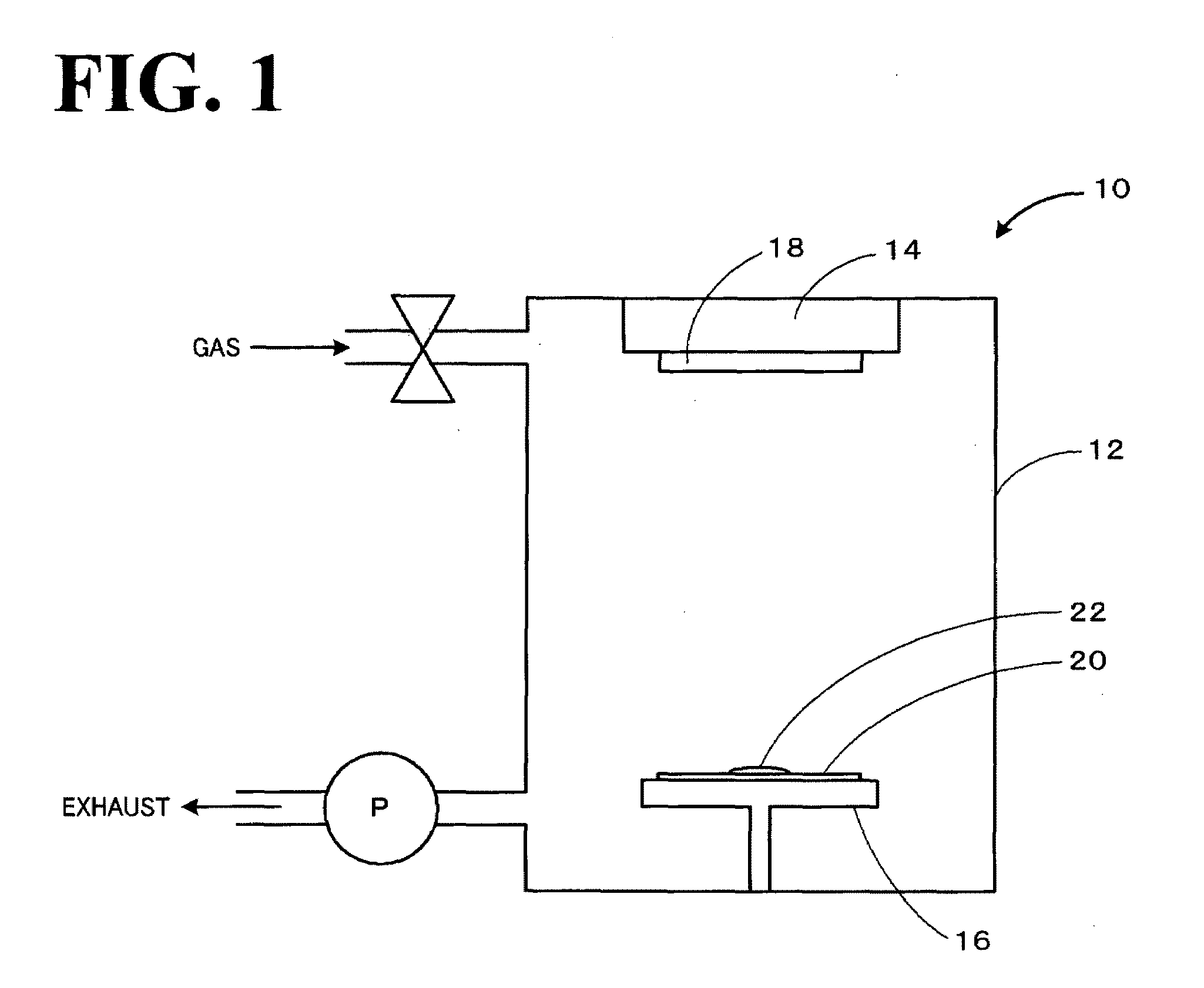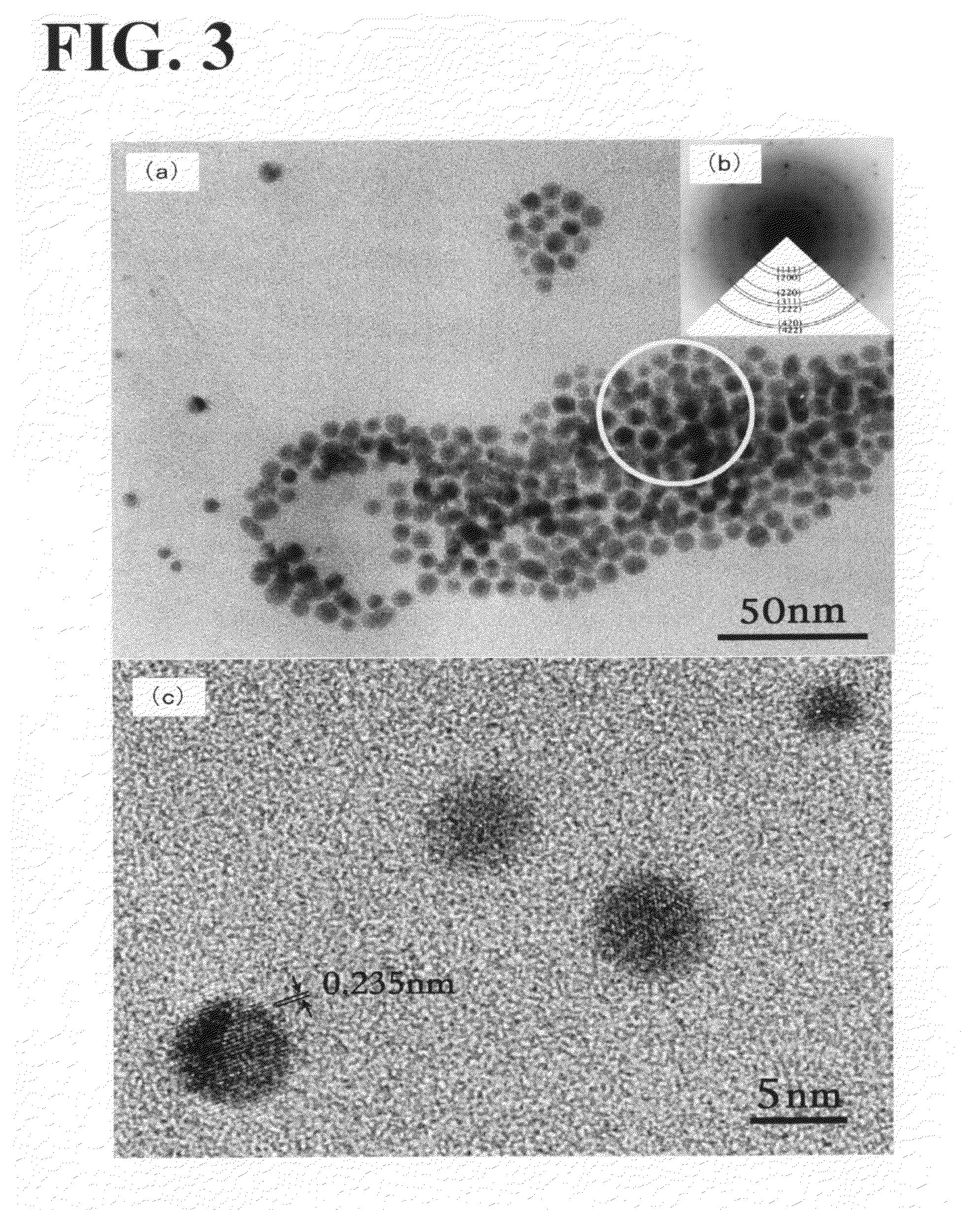Method for Producing Nanoparticles
a nanoparticle and nanotechnology, applied in the field of nanoparticle production, can solve the problems of complex operations to remove nanoparticles, inconvenient wet and dry processes in the related art, and the description of wet and dry processes, etc., and achieve the effect of not easy to aggrega
- Summary
- Abstract
- Description
- Claims
- Application Information
AI Technical Summary
Benefits of technology
Problems solved by technology
Method used
Image
Examples
example 1
[0033](1) Production of Gold Nanoparticles with EMI-BF4
[0034]On a slide glass (26 mm×76 mm), 0.60 cm3 of 1-ethyl-3-methylimidazolium tetrafluoroborate (EMI-BF4) was evenly placed. At this time, the EMI-BF4 was not spilled from the glass substrate because of its surface tension. This was placed in an evaporator (SIB-3, manufactured by Eiko Engineering Co., Ltd.). A target material composed of gold (a disk with a diameter of 50 mm and a thickness of 0.1 mm) was arranged at a position facing the EMI-BF4, and sputtering was performed with the gold target (evaporation chamber: filled with air, pressure: 20 Pa, evaporation current: about 5 mA, reaction time: 15 minutes). After the sputtering, the resulting EMI-EF4 solution on the surface of the slide glass was recovered.
(2) Measurement of Absorption Spectrum
[0035]FIG. 2 illustrates the absorption spectra of the EMI-BF4 solution after the sputtering. In FIG. 2, a solid line indicates the absorption spectrum of the EMI-BF4 solution, and a d...
example 2
[0037](1) Production of Gold Nanoparticles with TMPA-TFSI
[0038]Gold nanoparticles were synthesized as in Example 1, except that N,N,N-trimethyl-N-propylammonium bis(trifluoromethanesulfonyl)imide (TMPA-TFSI) was used as the ionic liquid. After sputtering, the resulting EMI-BF4 solution on the surface of the slide glass was recovered.
(2) Measurement of Absorption Spectrum
[0039]The absorption spectrum of the TMPA-TFSI solution after the sputtering is represented by the dotted line in FIG. 2. In the case of using the TMPA-TFSI as the ionic liquid, the surface plasmon absorption peak of the resulting gold nanoparticles was not observed. An absorption spectrum in which an absorption edge was observed at about 600 nm and the shoulder of the absorption curve was observed at about 350 nm was obtained. It has been reported that for gold nanoparticles having a particle size of about 10 nm or less, a decrease in particle size results in a decrease in surface plasmon peak intensity and a broad ...
example 3
(1) Production of Gold Nanoparticles
[0042]On a slide glass (26 mm×38 mm), 0.60 cm3 of EMI-BF4 was evenly placed. This was placed in an evaporator (JFC-1300, manufactured by JEOL Ltd). A target material composed of gold (a disk with a diameter of 57 mm and a thickness of 0.5 mm) was arranged at a position facing the EMI-BF4, and sputtering was performed with the gold target (evaporation chamber: filled with argon, pressure: 8 Pa, evaporation current: about 40 mA). The sputtering was performed for a reaction time of 0.5 minutes, 1 minute, 2 minutes, or 10 minutes. After the sputtering, the resulting EMI-BF4 solution on the surface of the slide glass was recovered.
(2) Relationship between Reaction Time and Particle Size
[0043]FIG. 6 shows the change in the absorption spectrum of the EMI-BF4 solution after the sputtering at the different reaction times. FIG. 6(b) shows spectra normalized with respect to the absorbance at 400 nm of the spectra shown in FIG. 6(a). As shown in FIG. 6(a), at...
PUM
| Property | Measurement | Unit |
|---|---|---|
| particle size distribution | aaaaa | aaaaa |
| particle size distribution | aaaaa | aaaaa |
| particle size | aaaaa | aaaaa |
Abstract
Description
Claims
Application Information
 Login to View More
Login to View More - R&D
- Intellectual Property
- Life Sciences
- Materials
- Tech Scout
- Unparalleled Data Quality
- Higher Quality Content
- 60% Fewer Hallucinations
Browse by: Latest US Patents, China's latest patents, Technical Efficacy Thesaurus, Application Domain, Technology Topic, Popular Technical Reports.
© 2025 PatSnap. All rights reserved.Legal|Privacy policy|Modern Slavery Act Transparency Statement|Sitemap|About US| Contact US: help@patsnap.com



